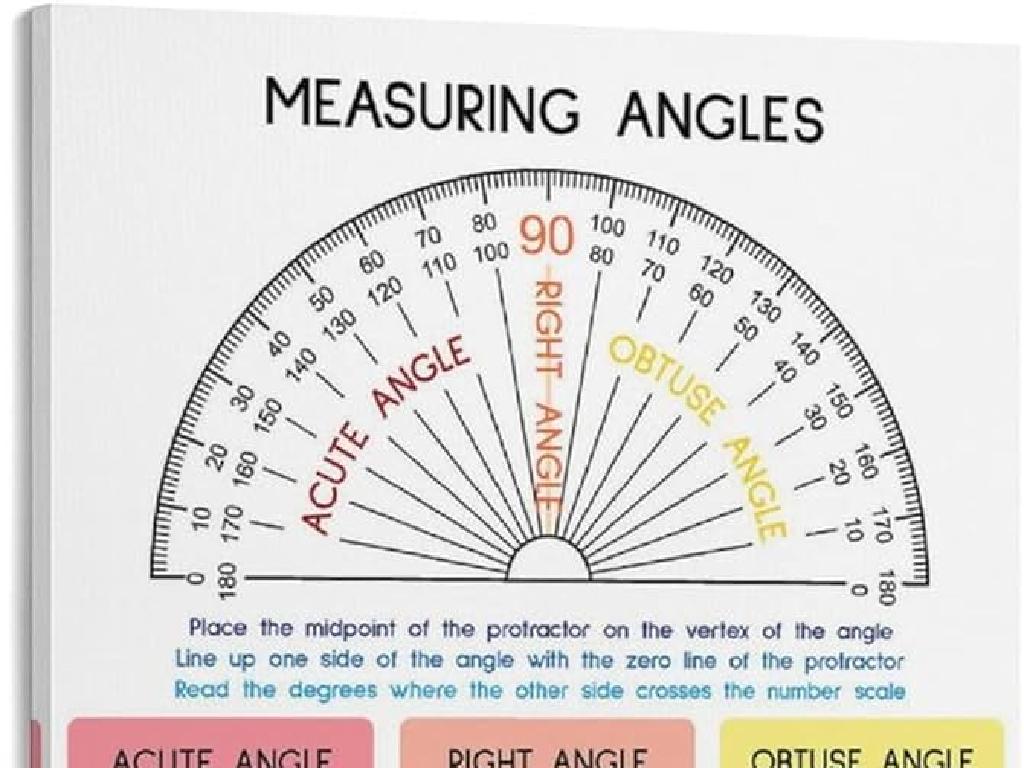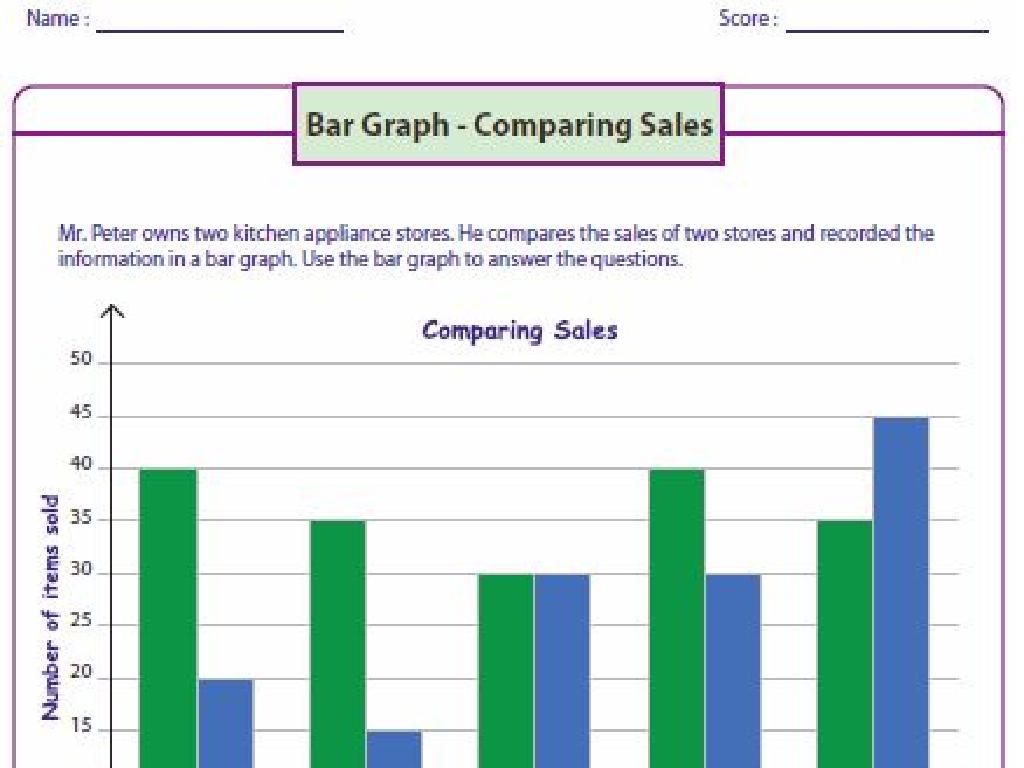Compare Decimals And Fractions On Number Lines
Subject: Math
Grade: Fifth grade
Topic: Compare Decimals And Fractions
Please LOG IN to download the presentation. Access is available to registered users only.
View More Content
Comparing Decimals and Fractions on Number Lines
– Understand decimals and fractions
– Decimals and fractions represent parts of whole numbers.
– Daily uses of decimals and fractions
– Used in money, measurements, and time.
– Learn to compare on number lines
– Visualize and order numbers by size on a line.
– Today’s goal: Master comparison
|
This slide introduces the concept of comparing decimals and fractions using number lines, a fundamental skill in fifth-grade mathematics. Begin by explaining that both decimals and fractions are ways to express parts of whole numbers, with decimals shown as points on a number line and fractions represented by segments. Highlight everyday situations where decimals and fractions are used, such as in financial transactions, cooking measurements, and telling time. The goal for today’s lesson is for students to learn how to place decimals and fractions on a number line and compare their values. Emphasize the importance of understanding the size of fractions and decimals relative to each other, which is a skill they will use in real-life scenarios. Provide examples and practice opportunities on number lines to solidify their understanding.
Understanding Decimals on Number Lines
– Decimals represent parts of a whole
– Like fractions, decimals show amounts less than one
– Decimals are related to the base-10 system
– Each decimal place is a power of 10
– Examples: 0.5, 0.75, 0.25
– 0.5 is half, 0.75 is three-quarters, 0.25 is one-quarter
– Placing decimals on a number line
– Visualize decimals by marking them between integers
|
This slide introduces the concept of decimals as parts of a whole, similar to fractions, and explains their relationship with the base-10 number system. Provide clear examples of common decimals and their equivalent fraction forms to help students make connections. Emphasize the importance of understanding how to place and compare decimals on a number line, as this skill is crucial for visualizing and comparing the size of different decimal values. Encourage students to practice by plotting various decimals on number lines and comparing their positions relative to each other and to whole numbers.
Understanding Fractions
– Fractions represent parts of a whole
– Like a slice of pizza is a part of a whole pizza
– Consist of a numerator and denominator
– Top number (numerator) shows how many parts we have, bottom number (denominator) shows how many parts make a whole
– Examples: 1/2, 3/4, 2/5
– 1/2 means half, 3/4 means three quarters, and 2/5 means two out of five equal parts
|
Begin by explaining that fractions are a way to represent parts of a whole, which is a concept students encounter in everyday life, such as slicing a pizza or sharing a bag of candy. The numerator and denominator in a fraction tell us how many parts we are considering and how many parts make up a whole, respectively. Provide examples of common fractions and use visual aids like pie charts or number lines to illustrate them. This will help students visualize fractions better and prepare them for comparing them on number lines.
Comparing Decimals and Fractions on Number Lines
– What is a number line?
– A straight line with numbers at equal spaces
– Number lines show order of numbers
– It helps us see which numbers are bigger or smaller
– Comparing decimals on a number line
– Place decimals on the line to see which is larger
– Comparing fractions on a number line
– Place fractions on the line to find their value
|
This slide introduces the concept of a number line and its use in comparing decimals and fractions, which is a key skill in fifth-grade math. Start by explaining what a number line is and how it is set up. Emphasize that the equal spacing of numbers is crucial for accurately determining the value of numbers. Demonstrate how to locate decimals on a number line, ensuring students understand that decimals are another way to represent fractions. Similarly, show how to place fractions on a number line by finding equivalent decimals or by dividing the number line into equal parts. Use examples like 0.75 and 3/4 to illustrate how a decimal and a fraction can represent the same point on a number line. Encourage students to practice by placing various decimals and fractions on number lines to compare their sizes.
Placing Decimals on a Number Line
– Decimals in ascending order
– Like numbers, decimals increase from left to right.
– Points represent decimal values
– Each mark on the line matches a specific decimal.
– Example: 0.3, 0.6, 0.8 placements
– Visualize 0.3, 0.6, 0.8 on the line to understand their order.
|
This slide is aimed at helping fifth-grade students understand how to place and compare decimals on a number line. Emphasize that decimals, much like whole numbers, are arranged from the smallest to the largest as we move from left to right on the number line. Each point or mark on the number line corresponds to a decimal value, and students should practice placing decimals in the correct order. Use the example provided to show where 0.3, 0.6, and 0.8 would be located, ensuring to point out that 0.3 is closer to 0, 0.6 is midway between 0.5 and 1, and 0.8 is just before 1. Encourage students to draw their own number lines and place decimals at the correct points to reinforce the concept.
Placing Fractions on a Number Line
– Fractions fit on number lines too
– Divide spaces into equal parts
– Imagine cutting a cake into equal slices
– Example: 1/2, 3/4, and 2/5 on a line
– 1/2 is in the middle, 3/4 is three quarters along, and 2/5 is two fifths along
– Understanding fractions’ relative size
– See which fractions are bigger or smaller
|
This slide introduces the concept of placing fractions on a number line, which helps students visualize and compare the size of different fractions. Emphasize that just like whole numbers, fractions have a specific place on the number line. The space between each whole number can be divided into equal parts to represent fractions. Use the example of common fractions like 1/2, 3/4, and 2/5 to show their placement. Encourage students to think of the number line as a ruler where each fraction is a point that measures a certain distance from zero. This visual representation aids in understanding the relative size of fractions and is a foundational skill for comparing both fractions and decimals.
Comparing Decimals and Fractions on Number Lines
– How to compare on a number line
– Look at where numbers sit on the line
– Right side means greater value
– Example: 0.75 vs 3/4
– Both 0.75 and 3/4 are at the same point, showing they’re equal
– Visualizing decimal and fraction
– See how decimals and fractions correspond
|
This slide is aimed at teaching students how to compare decimals and fractions by using a number line. Emphasize that the position of a number on the number line determines its value relative to others; numbers further to the right are greater. Use the example of 0.75 and 3/4 to show that they occupy the same position on the number line, illustrating their equality. Encourage students to draw their own number lines and plot both decimals and fractions to see the visual relationship between them. This will help solidify their understanding of the concept that different representations can reflect the same value.
Equivalent Decimals and Fractions
– Decimals and fractions can be equal
– Example: 0.5 equals 1/2
– Half of a dollar is the same as 50 cents
– Use multiplication/division for equivalents
– Multiply or divide to convert between forms
– Practice with different numbers
– Try converting 0.75 to a fraction and vice versa
|
This slide introduces the concept that decimals and fractions can represent the same value and are therefore equivalent. Start by explaining that decimals are another way to express fractions and vice versa. Use relatable examples, such as money, to illustrate this point. For instance, 0.5 dollars is the same as 1/2 of a dollar. Teach students how to find equivalent fractions and decimals by using multiplication or division. For example, to convert 0.75 to a fraction, students can think of it as 75/100, which simplifies to 3/4. Encourage students to practice with different numbers to become comfortable with the concept. Provide several examples and exercises for students to work on, both in class and as homework.
Number Line Challenge: Decimals vs. Fractions
– Create your own number lines
– Place decimals and fractions
– Compare 0.3 and 1/3 on the line
– Use the number line to visually compare the positions of 0.3 and 1/3
– Discuss: Which is greater and why?
– Think about the space each number takes on the line
|
This class activity is designed to help students visually understand the relationship between decimals and fractions on a number line. Provide students with a set of decimals and fractions to place on their number lines. Encourage them to carefully consider the scale of their number lines to accurately represent each number. For the comparison of 0.3 and 1/3, guide them to see that 1/3 is just a little more than 0.3 (since 1/3 is equivalent to 0.333…). This activity will reinforce their understanding of number value and the concept that different representations can reflect the same or similar values. Possible variations for the activity could include using different pairs of decimals and fractions, having students work in pairs to create larger number lines, or challenging them to find equivalent pairs.
Conclusion: Decimals and Fractions on Number Lines
– Review placing decimals on number lines
– Review placing fractions on number lines
– Discuss comparing decimal and fraction values
– Which is greater: 0.75 or 3/4? They are equal on a number line!
– Open floor for questions and clarification
|
As we wrap up today’s lesson, let’s revisit the key concepts we’ve learned. Remember, placing decimals on a number line involves identifying the correct interval between whole numbers. Similarly, when placing fractions, consider the numerator and the denominator to find its position. To compare decimals and fractions, convert them to the same form or visually analyze their positions on the number line. Now, let’s take some time to address any questions you may have. It’s important that you feel confident in these skills, as they are foundational for understanding more complex mathematical concepts. Don’t hesitate to ask for examples or further explanation if something isn’t clear.






